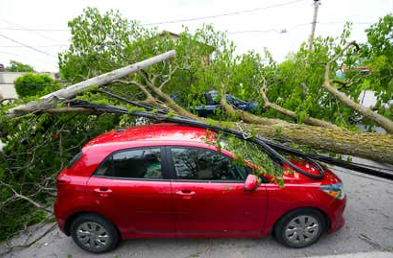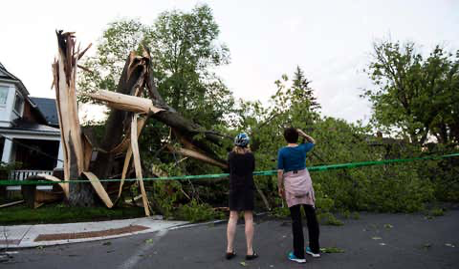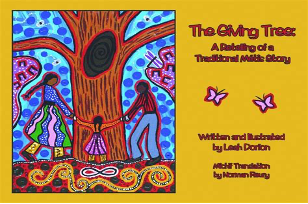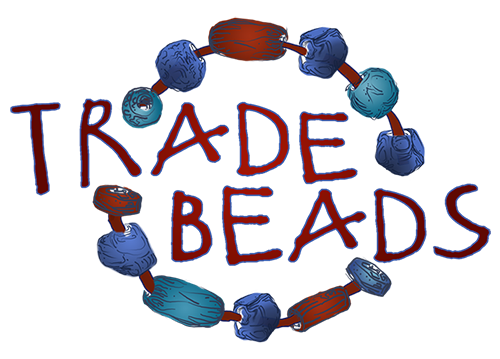Trees are Good Medicine
Linda Cauchy
Métis Women's Circle
March 27, 2024
In the Spring of 2022 a violent weather event called a derecho swept through Southern Ontario, the Ottawa Valley, and Western Quebec. The force of the winds was something I'd never before witnessed.
This fifteen-minute derecho left a swath of destruction; smashed roofs, downed power lines, and up-rooted and snapped trees. After the event (and the ensuing power outage) we surveyed our property for damage and began the clean-up. We were fortunate in that no tree fell onto our house and we lost only five trees, some of whom are generously heating my house today.  In response to
this weather event, the Provincial Hydro company enhanced its monitoring routine,
In response to
this weather event, the Provincial Hydro company enhanced its monitoring routine,  identifying sick or ailing trees that may fall on powerlines and disrupt service. On our property, one tall old maple was identified for felling. The tree looked fine to me and I was saddened at the prospect of losing this tree from our forest. My emotional response prompted me to investigate why I should feel this way. I remembered a quote from Thomas King which helps me to contextualize my feelings.
https://weather.com/photos/news/2022-05-23-canada-derecho-photos
identifying sick or ailing trees that may fall on powerlines and disrupt service. On our property, one tall old maple was identified for felling. The tree looked fine to me and I was saddened at the prospect of losing this tree from our forest. My emotional response prompted me to investigate why I should feel this way. I remembered a quote from Thomas King which helps me to contextualize my feelings.
https://weather.com/photos/news/2022-05-23-canada-derecho-photos
King writes:
So, let's agree that Indians (insert Métis here) are not special. We're not... mystical. I'm fine with that. Yes, a great many Native people have a long-standing relationship with the natural world. But that relationship is equally available to non-Natives, should they choose to embrace it. The fact of Native existence is that we live modern lives informed by traditional values and contemporary realities and that we wish to live those lives on our terms.
- Thomas King, The Inconvenient Indian: a Curious Account of Native People in North America. [Toronto]:Anchor Canada, 2013.
So, here it is, a long-standing relationship with the natural world that I choose to integrate into my modern life. Makes sense to me. With this understanding, I want to honour trees, the rooted ones, by sharing some thoughts and experiences.
 Ten years ago, I participated in an education forum as an Iindigenous educator and was leading a session on Métis; a rather large topic for a 45 minute workshop. I chose Leah Dorion's The Giving Tree (Gabriel Dumont Institute, 2009), a retelling of the traditional Métis story, as the starting point to introduce educators to Métis values and beliefs, and our long close relationship with nature. As the story goes, the giving tree was located mid-way between Métis communities on the prairie. Families would stop for tea, and bannock, and rest at the tree before continuing their journey. A hollow in the tree became the trade and message centre for the families. Goods for those in need were left in the hollow as were messages and gifts to be delivered to friends and relatives in surrounding communities. This tree was valued and loved by the families. The anticipation of perhaps finding something left for oneself heightened this appreciation. Although only a tree, it was the hub of the communities and played an essential role in spreading the good medicine throughout the community. An interesting contemporary notion of the giving tree is the Métis Nation BC's Northern Health Aboriginal Health Improvement Committee (AHIC) initiative of July 2021 (https://www.mnbc.ca/news/giving-tree). Housed at the Niwi_owin Métis Family Service, this Giving Tree was designed to provide resources, gifts, and crafts to families, free for the taking with the goal of making connections to Métis values and traditions centred around families and well-being. Urban Métis may be distanced from the natural world but their relationship can be developed in creative and meaningful ways.
Ten years ago, I participated in an education forum as an Iindigenous educator and was leading a session on Métis; a rather large topic for a 45 minute workshop. I chose Leah Dorion's The Giving Tree (Gabriel Dumont Institute, 2009), a retelling of the traditional Métis story, as the starting point to introduce educators to Métis values and beliefs, and our long close relationship with nature. As the story goes, the giving tree was located mid-way between Métis communities on the prairie. Families would stop for tea, and bannock, and rest at the tree before continuing their journey. A hollow in the tree became the trade and message centre for the families. Goods for those in need were left in the hollow as were messages and gifts to be delivered to friends and relatives in surrounding communities. This tree was valued and loved by the families. The anticipation of perhaps finding something left for oneself heightened this appreciation. Although only a tree, it was the hub of the communities and played an essential role in spreading the good medicine throughout the community. An interesting contemporary notion of the giving tree is the Métis Nation BC's Northern Health Aboriginal Health Improvement Committee (AHIC) initiative of July 2021 (https://www.mnbc.ca/news/giving-tree). Housed at the Niwi_owin Métis Family Service, this Giving Tree was designed to provide resources, gifts, and crafts to families, free for the taking with the goal of making connections to Métis values and traditions centred around families and well-being. Urban Métis may be distanced from the natural world but their relationship can be developed in creative and meaningful ways.
Another creative way of engaging with trees that has gained in popularity recently is the idea of forest bathing. The Japanese are credited with having formalized the concept of shinrin-yoku or forest bathing and integrating it into their health care system in the 1980s. The practice is believed to improve the health of the mind, body and spirit, just by being in a forest. A new form of alternative medical science called Forest Medicine has been developed with studies providing evidence that forest bathing can reduce blood pressure, may have a preventative effect on cancer, reduces stress, and improve sleep; the list of benefits is long and impressive (https://www.ncbi.nlm.nih.gov/pmc/articles/PMC9665958/). Curiously, this knowledge of the benefits of a relationship with trees is not new and has been practiced by Indigenous people for eons. Perhaps for pre-colonial Indigenous people the relationship with trees was more pragmatic as trees provided shelter, food, medicine, transportation; the health effects were a well-appreciated corollary benefit. As with many good things, modernity tries to standardize and formalize (and appropriate) these old ways and knowledges. Giving a new name to an old practice makes it attractive and easily monetized. There exists a plethora of forest bathing retreats and guided excursions with pre-determined rituals in order to get the most from a forest bathing experience... at a cost. Seems to be over the top when one can simply go for a long slow walk in a forest with open ears, eyes, and heart. It was on one of these long slow walks that I had a humbling experience with trees.
While vacationing in California in the San Francisco area, I was strongly encouraged to visit the Muir Woods National Monument not far across the Golden Gate Bridge. The Muir Woods is a 554-acre area protecting some of the last stands of old growth coastal redwood forests in California. It is with great thanks to some forward thinking "non-Natives" who had an important and deep relationship with the natural world that these trees were saved from exploitation. Fortunately, the William Kent family had the financial resources and political connections to protect these trees and the land. In 1908 the American President, Theodore Roosevelt, proclaimed this forest protected under the American Antiquities Act, signed it into law, and named it, on Kent's insistence, after the American naturalist John Muir.
 Entering into this Monument stirs the heart. I was immediately struck by how quiet the world had become; there was a strong sense of calm with an equally strong sense of energy, not quite a buzz but palpable. I was in awe of the trees' size and commanding presence. These giant living entities have stood for so long and seen so much; I felt puny, ephemeral, and humbled.
Entering into this Monument stirs the heart. I was immediately struck by how quiet the world had become; there was a strong sense of calm with an equally strong sense of energy, not quite a buzz but palpable. I was in awe of the trees' size and commanding presence. These giant living entities have stood for so long and seen so much; I felt puny, ephemeral, and humbled.
 I walked further into the forest and a flurry of mixed emotions surfaced within me; joy that these trees were saved through deliberate acts of preservation and foresight, enabling them to continue their work as trees, and also sadness that so many were felled or flooded out. Such a loss. After spending a couple of hours on a long slow walk in this forest, it was time to leave. I left taking with me a sense of lightness, calm, and appreciation. This was good medicine for sure.
Nurturing our Métis long-standing relationship with the natural world can take many forms. Honouring and appreciating the trees is only one such way. Next time you are told to take a hike, make it a long slow walk in a forest.
I walked further into the forest and a flurry of mixed emotions surfaced within me; joy that these trees were saved through deliberate acts of preservation and foresight, enabling them to continue their work as trees, and also sadness that so many were felled or flooded out. Such a loss. After spending a couple of hours on a long slow walk in this forest, it was time to leave. I left taking with me a sense of lightness, calm, and appreciation. This was good medicine for sure.
Nurturing our Métis long-standing relationship with the natural world can take many forms. Honouring and appreciating the trees is only one such way. Next time you are told to take a hike, make it a long slow walk in a forest.
Linda Cauchy
Muir Woods photo credits:
https://en.wikipedia.org/wiki/Muir_Woods_National_Monument#/media/File:Muir_Woods_National_Monument,_Marin_County,_California.jpg
Posted
ARCHIVE
| March 27, 2024 | Trees are Good Medicine |
| January 24, 2024 | The Enduring Impacts of Colonial Violence |
| September 25, 2023 | Loon Summer |
| April 29, 2022 | To Apologize |
| April 28, 2022 | Developing Healthy Water Routines |
| April 25, 2022 | Water is Not a Noun |
| May 12, 2021 | The Flower Beadwork People |
| May 1, 2021 | Good Riddance Beyak |
| April 1, 2021 | Another Day in Paradise |
| March 1, 2021 | All My Relations Matter More Now Than Ever |
| January 21, 2021 | "Look Out The Window, Quick" |
SUBMISSION GUIDELINES
The purpose of Trade Beads is to inform and inspire our readers within the overall theme of Indigenous experience. Broadly, themes will follow the four seasons, but posts are not limited by these categories. We consider submissions by students, artists and community members at large. TradeBeads is supported by the Métis Women's Circle, whose mission statement is as follows;
We are a circle of Métis women who support, educate and empower our women and their families. We acknowledge the Creator and the wholistic relationship between the earth and the gifts provided to us. Through reciprocity and the healing journey we can help our people reclaim and celebrate our cultures, histories and identities.
Submission Criteria
- Please submit original posts, not previously published. Submissions should be 500-1,000 words in length, in MS Word format, emailed as an attachment to info@metiswomenscircle.ca
- Include your name, contact information, formal association and community affiliation if applicable.
- Author bios should be brief, no more than three sentences.
- If author image is submitted, minimum 300x300 pixels.
- We do not publish every post submitted, but we will respond within two weeks, with explanations. We reserve the right to re-post accepted submissions in email lists, list serves or promotional materials.


